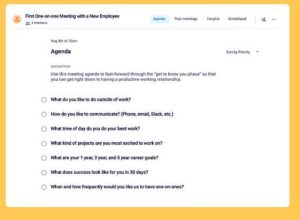What Should Be Included in a One-on-One Meeting Agenda?
Effective one-on-one meetings are pivotal for managerial success and employee development. Crafting an agenda that is both comprehensive and specific can significantly enhance the productivity of these sessions. This article delves into the critical elements that should be included in a one-on-one meeting agenda, ensuring that each meeting is a powerful tool for mutual growth and goal achievement.

Set Clear Objectives
Begin each one-on-one meeting by clearly defining the objectives for the session. Whether the focus is on feedback, career development, project updates, or problem-solving, establishing the purpose at the outset provides a clear direction and helps keep the conversation on track. For example, if the goal is to discuss performance, state specific projects or behaviors that will be reviewed.
Review Progress on Goals
A key section of any one on one agenda should involve reviewing the progress on previously set goals. Discuss achievements and setbacks with specific metrics or milestones. If an employee had a target of increasing sales by 10% over the quarter, review the actual performance against this target. This not only encourages a culture of accountability but also helps in setting future objectives.
Discuss New Developments
Update each other on any new developments that impact the employee’s role or the broader team. This might include organizational changes, updates on key projects, or new initiatives. Being transparent about changes and their potential impact fosters trust and helps the employee navigate the changing landscape more effectively.
Address Challenges and Offer Support
Identifying and discussing challenges that the employee faces is crucial. This is the time to explore hurdles in current projects or personal impediments to professional growth. Offer guidance, resources, and support to help overcome these challenges. This could range from suggesting training programs to reassigning tasks to better align with the employee’s strengths.
Plan for the Future
Future planning is essential for motivating employees and aligning their career trajectory with organizational goals. Discuss potential future projects, skills that the employee should develop, and steps they can take to prepare for advanced roles. For instance, if an employee shows potential for leadership, you might suggest they take on a mentorship role within the team to develop necessary skills.
Feedback Exchange
Encourage a two-way feedback exchange. Managers should provide constructive feedback on the employee’s work and also solicit feedback on their own management style. This exchange promotes a healthy work environment where continuous improvement is the norm.
Wrap Up with Clear Action Items
End the meeting with a summary of discussed points and clear action items. Assign responsibilities and deadlines for each task to ensure accountability. This structured conclusion helps both parties leave the meeting with a clear understanding of expectations and next steps.
Crafting a robust one-on-one meeting agenda ensures that time is used efficiently and both the manager and employee leave the meeting with a clear sense of direction and purpose. Use these guidelines to transform your one-on-one meetings into pivotal growth opportunities.